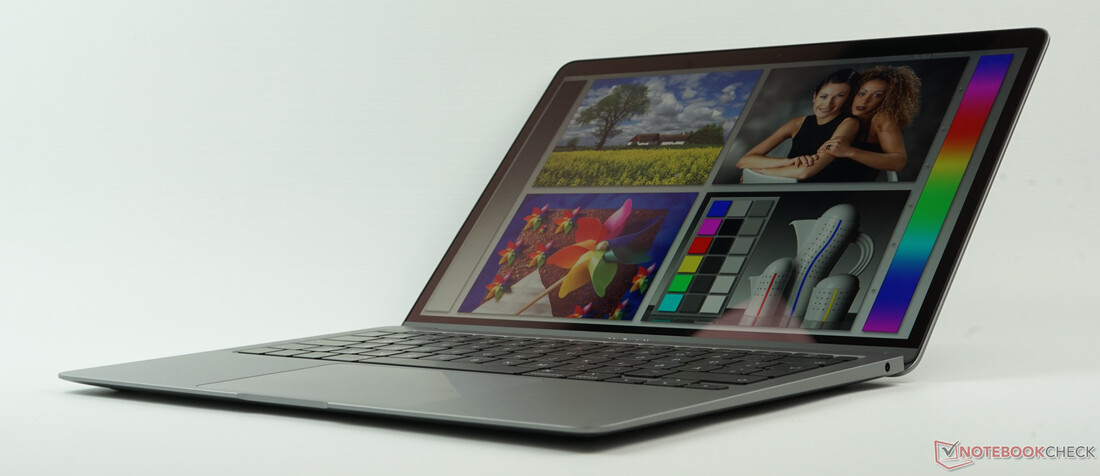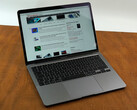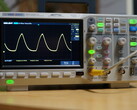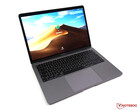The new 2020 MacBook Air Core i5 has arrived: Faster CPU, but still way too loud
After Apple has already replaced the problematic Butterfly keyboard in the larger MacBook Pro with a conventional keyboard design, we now also get the new keyboard in Apple's smallest laptop, the MacBook Air. During our last review, we were actually not sure whether Apple will use the new keyboard for the MacBook Air because it requires more vertical space. The new model is actually slightly thicker than before, even though Apple does not really advertise this fact in the press information. At 15.9 vs. 16.1 mm (at the thickest spot), however, the difference is small and we actually prefer this development. To be honest, you cannot really notice the difference in practice, either.
Another big issue of the previous model, especially considering the high price, was the slow processor. Intel's Core i5-8210Y was an ultra-low-voltage processor with two cores and very low performance headroom. Apple wants to change that with custom processors from Intel. They still belong to the ultra-low-voltage Y-series, but are now based on the modern Ice Lake architecture, so the graphics performance in particular is increased. The default processor is still a dual-core Core i3, but you can also get a Core i5 or even Core i7 quad-core. These custom Apple CPUs have a slightly higher TDP and therefore higher clock rates. These CPUs also have smaller package sizes, even though this is not really interesting for the customer.
This leaves us with the cooling solution and how it handles the new CPU options. The SoC of the MacBook Air is once again passively cooled. Yes, there is a small fan inside the chassis, but there is no heat pipe that connects it with the heat sink. It is only supposed to improve the air flow in the chassis. As we have heard in the review of the predecessor, the small fan can get really loud (during the installation of applications or when you run more complex tasks, for example). The heat sink of the new 2020 MacBook Air is a bit bigger than before, but there is still no direct connection to the fan.
Our test unit is the Core i5 model of the MacBook Air for 1499 Euros or $1299 US, respectively. We purchased the unit in Apple's standard online shop. In addition to the quad-core processor, the laptop is equipped with 8 GB LPDDR4X-RAM and 512 GB SSD storage which should be completely sufficient for many users.
Performance: Ice-Lake-Y Core i5 with Iris Plus Graphics G7
Our initial benchmarks show that the cooling solution is basically identical to the previous model. Thanks to the new processor architecture and the additional cores, the performance has improved, but it is still clearly behind the rivals equipped with regular 15W CPUs. The best Cinebench R15 Multi result is the first run with 448 points with an average of around 400 points after 25 iterations. By the way, the Core i5-1030NG7 performs almost identically on battery power.
| Cinebench R15 | |
| CPU Single 64Bit | |
| Apple MacBook Pro 16 2019 i9 5500M (macOS 10.15.1) | |
| Apple MacBook Pro 16 2019 i9 5500M | |
| Apple MacBook Pro 15 2018 (2.6 GHz, 560X) | |
| Acer Swift 3 SF313-52-71Y7 | |
| Dell XPS 13 9300 i5 FHD | |
| Apple MacBook Pro 13 2019 2TB3 | |
| Apple MacBook Air 2020 i5 (macOS 10.15) | |
| Apple Macbook Air 2019 | |
| CPU Multi 64Bit | |
| Apple MacBook Pro 16 2019 i9 5500M (macOS 10.15.1) | |
| Apple MacBook Pro 16 2019 i9 5500M (Win 10) | |
| Apple MacBook Pro 15 2018 (2.6 GHz, 560X) (macOS Software Update) | |
| Apple MacBook Pro 15 2018 (2.6 GHz, 560X) (macOS Software Update 2) | |
| Apple MacBook Pro 15 2018 (2.6 GHz, 560X) (macOS Catalina 10.15.5) | |
| Apple MacBook Pro 15 2018 (2.6 GHz, 560X) (macOS) | |
| Dell XPS 13 9300 i5 FHD (Ultra-Performance) | |
| Dell XPS 13 9300 i5 FHD (Optimized) | |
| Apple MacBook Pro 13 2019 2TB3 | |
| Acer Swift 3 SF313-52-71Y7 | |
| Apple MacBook Air 2020 i5 (macOS 10.15) | |
| Apple Macbook Air 2019 | |
| Geekbench 5.0 | |
| 5.0 Multi-Core | |
| Apple MacBook Pro 16 2019 i9 5500M (Win 10) | |
| Apple MacBook Pro 16 2019 i9 5500M (mac OS 15.1.0) | |
| Apple MacBook Pro 15 2018 (2.6 GHz, 560X) (Mac OS 10.15.1) | |
| Acer Swift 3 SF313-52-71Y7 | |
| Apple MacBook Pro 13 2019 2TB3 | |
| Apple iPhone 11 Pro | |
| Dell XPS 13 9300 i5 FHD | |
| Apple MacBook Air 2020 i5 | |
| Apple Macbook Air 2019 | |
| 5.0 Single-Core | |
| Apple iPhone 11 Pro | |
| Acer Swift 3 SF313-52-71Y7 | |
| Apple MacBook Pro 16 2019 i9 5500M (mac OS 15.1.0) | |
| Apple MacBook Pro 16 2019 i9 5500M (Win 10) | |
| Apple MacBook Air 2020 i5 | |
| Apple MacBook Pro 15 2018 (2.6 GHz, 560X) (Mac OS 10.15.1) | |
| Apple MacBook Pro 13 2019 2TB3 | |
| Dell XPS 13 9300 i5 FHD | |
| Apple Macbook Air 2019 | |
| Geekbench 5.5 | |
| Multi-Core | |
| Apple MacBook Pro 16 2019 i9 5500M (Win 10) | |
| Apple MacBook Pro 15 2018 (2.6 GHz, 560X) (Big Sur) | |
| Acer Swift 3 SF313-52-71Y7 | |
| Dell XPS 13 9300 i5 FHD | |
| Apple iPhone 11 Pro | |
| Apple MacBook Air 2020 i5 (macOS) | |
| Apple MacBook Air 2020 i5 (Win 10) | |
| Single-Core | |
| Apple iPhone 11 Pro | |
| Acer Swift 3 SF313-52-71Y7 | |
| Dell XPS 13 9300 i5 FHD | |
| Apple MacBook Air 2020 i5 (macOS) | |
| Apple MacBook Air 2020 i5 (Win 10) | |
| Apple MacBook Pro 15 2018 (2.6 GHz, 560X) (Big Sur) | |
| Apple MacBook Pro 16 2019 i9 5500M (Win 10) | |
| Blackmagic RAW Speed Test - 12:1 8K CPU | |
| Apple MacBook Pro 16 2019 i9 5500M | |
| Apple MacBook Pro 15 2018 (2.6 GHz, 560X) | |
| Apple MacBook Air 2020 i5 | |
We can see the biggest performance increase in the graphics section thanks to the Iris Plus Graphics G7 with 64 EUs. Compared to the old MacBook Air, we are talking about roughly twice the graphics performance according to our initial synthetic benchmarks. The results is about on par with the "small" MacBook Pro 13 2019 with 2x Thunderbolt 3. The smaller UHD Graphics G1 (see XPS 13 9300 Core i5, for example) is also beaten, but it cannot keep up with the Iris Plus Graphics G7 of the more powerful XPS 13 9300 Core i7 (+42%). Furthermore, there is significant throttling in the 3DMark stress test (-20%).
| Blackmagic RAW Speed Test - 12:1 8K Metal | |
| Apple MacBook Pro 16 2019 i9 5500M | |
| Apple MacBook Air 2020 i5 | |
Keyboard is good, fan is still annoying
The switch to the new keyboard is definitely a welcome change. Some users were pretty happy with the old Butterfly keyboard thanks to its very precise (yet shallow) key travel, but there have been plenty of reliability problems over the last couple of years. The new keyboard is pretty similar to the larger MacBook Pro 16 in terms of subjective typing experience.
The fan behavior is also very similar to the predecessor and longer workloads (not only synthetic load, but also longer installations, for example) results in a very loud fan noise. At around 30% CPU load (installation of OS updates), the fan is clearly audible and we are already above 40 dB(A), which is hard to understand considering the low performance level. We can even measure up to 45 dB(A) under heavier 3D workloads. We will continue to observe the situation until the review is complete.
Speaking of the full review: It will be published in the next couple of days. Please leave a comment if you have specific questions or suggestions for the test.
















